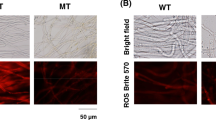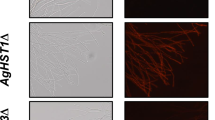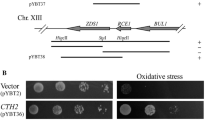Abstract
Iron deficiency causes oversynthesis of riboflavin in several yeast species, known as flavinogenic yeasts. Under iron deprivation conditions, Pichia guilliermondii cells increase production of riboflavin and malondialdehyde and the formation of protein carbonyl groups, which reflect increased intracellular content of reactive oxygen species. In this study, we found that P. guilliermondii iron deprived cells showed dramatically decreased catalase and superoxide dismutase activities. Previously reported mutations rib80, rib81, and hit1, which affect repression of riboflavin synthesis and iron accumulation by iron ions, caused similar drops in activities of the mentioned enzymes. These findings could explain the previously described development of oxidative stress in iron deprived or mutated P. guilliermondii cells that overproduce riboflavin. Similar decrease in superoxide dismutase activities was observed in iron deprived cells in the non-flavinogenic yeast Saccharomyces cerevisiae.







Similar content being viewed by others
References
Abbas CA, Sibirny AA (2011) Genetic control of biosynthesis and transport of riboflavin and flavin nucleotides and construction of robust biotechnological producers. Microbiol Mol Biol Rev 75:321–360
Boretsky Y, Protchenko O, Prokopiv T, Mukalov I, Fedorovych D, Sibirny A (2007) Mutations and environmental factors affecting regulation of riboflavin synthesis and iron assimilation also cause oxidative stress in the yeast Pichia guilliermondii. J Basic Microbiol 47:371–377
Bridges SM, Salin ML (1981) Distribution of iron-containing superoxide dismutase in vascular plants. Plant Physiol 68:275–278
Chauhan N, Latge JP, Calderone R (2006) Signalling and oxidant adaptation in Candida albicans and Aspergillus fumigatus. Nat Rev Microbiol 4:435–444
Cizewski-Culotta V, Klomp LWJ, Strain J et al (1997) The copper chaperone for superoxide dismutase. J Biol Chem 272:23469–23472
Cohen G, Fessl F, Traczyk A, Rytka J, Ruis H (1985) Isolation of the catalase A gene of Saccharomyces cerevisiae by complementation of the ctal mutation. Mol Gen Genet 200:74–79
Dalle-Donne I, Rossi R, Giustarini D, Milzani A, Colombo R (2003) Protein carbonyl groups as biomarkers of oxidative stress. Clin Chim Acta 329:23–38
Davidson JF, Whyte B, Bissinger PH, Schiestl RH (1996) Oxidative stress is involved in heat-induced cell death in Saccharomyces cerevisiae. Proc Natl Acad Sci USA 93:5116–5121
Enary TM (1955) Effect of cobalt and iron on riboflavin by Candida guilliermondii. Acta Chem Scand 9:19–23
Fedorovich DV, Kityk IV, Dzhala VI, Protchenko OV, Shavlovskii GM (1997) Accumulation and redox transformations of iron in the yeast Pichia guilliermondii and its flavinogenic mutants. Mikrobiologiya 66:48–51 (in Russian)
Fedorovich D, Protchenko O, Lesuisse E (1999) Iron uptake by the yeast Pichia guilliermondii. Flavinogenesis and reductive iron assimilation are co-regulated processes. Biometals 12:295–300
De Freitas JM, Liba A, Meneghini R, Valentine JS, Gralla EB (2000) Yeast lacking Cu–Zn superoxide dismutase show altered iron homeostasis. Role of oxidative stress in iron metabolism. J Biol Chem 275:11645–11649
Fridovich I (1998) Oxygen toxicity: a radical explanation. J Exp Biol 201:1203–1209
Hsu PC, Yang CY, Lan CY (2011) Candida albicans Hap43 is a repressor induced under low-iron conditions and is essential for iron-responsive transcriptional regulation and virulence. Eukaryot Cell 10:207–225
Hwang CS, Baek YU, Yim HS, Kang SO (2003) Protective roles of mitochondrial manganese-containing superoxide dismutase against various stresses in Candida albicans. Yeast 20:929–941
Hwang CS, Rhie GE, Kim ST et al (1999) Copper- and zinc-containing superoxide dismutase and its gene from Candida albicans. Biochim Biophys Acta 1427:245–255
Hwang CS, Rhie GE, Oh JH et al (2002) Copper- and zinc-containing superoxide dismutase is required for the protection from oxidative stresses and full virulence in Candida albicans. Microbiology 148:3705–3713
Irazusta V, Moreno-Cermeno A, Cabiscol E, Ros J, Tamarit J (2008) Major targets of iron-induced protein oxidative damage in frataxin-deficient yeasts are magnesium-binding proteins. Free Radic Biol Med 44:1712–1723
Jensen LT, Cizewski-Culotta V (2000) Role of Saccharomyces cerevisiae ISA1 and ISA2 in iron homeostasis. Mol Cell Biol 20:3918–3927
Kang HA, Jung MS, Hong WK et al (1998) Expression and secretion of human serum albumin in the yeast Saccharomyces cerevisiae. J Microbiol Biotechnol 8:42–48
Lamarre C, Le May JD, Deslauriers N, Bourbonnais Y (2001) Candida albicans expresses an unusual cytoplasmic manganese-containing superoxide dismutase (SOD3 gene product) up on the entry and during the stationary phase. J Biol Chem 276:43784–43791
Lenz AG, Costabel U, Shaltiel S, Levine RL (1989) Determination of carbonyl groups in oxidatively modified proteins by reduction with tritiated sodium borohydride. Anal Biochem 177:419–425
Lowry OH, Rosebrough NJ, Farr AL, Randall RJ (1951) Protein measurement with the Folin phenol reagents. J Biol Chem 193:265–275
Martchenko M, Alarco AM, Harcus D, Whiteway M (2004) Superoxide dismutases in Candida albicans: transcriptional regulation and functional characterization of the hyphal-induced SOD5 gene. Mol Biol Cell 15:456–467
Meneghini R (1997) Iron homeostasis, oxidative stress, and DNA damage. Free Radic Biol Med 23:783–792
O’Brien KM, Dirmeier R, Engle M, Poyton RO (2004) Mitochondrial protein oxidation in yeast mutants lacking manganese-(MnSOD) or copper- and zinc-containing superoxide dismutase (CuZnSOD): evidence that MnSOD and CuZnSOD have both unique and overlapping functions in protecting mitochondrial proteins from oxidative damage. J Biol Chem 279:51817–51827
Protchenko OV, Boretsky YR, Romanyuk TM, Fedorovych DV (2000) Oversynthesis of riboflavin by yeast Pichia guilliermondii in response to oxidative stress. Ukr Biokhim J 72:19–23
Raychaudhuri S, Reddy MM, Rajkumar NR, Rajasekharan R (2003) Cytosolic iron superoxide dismutase is a part of the triacylglycerol biosynthetic complex in oleaginous yeast. Biochem J 372:587–594
Rhie GE, Hwang CS, Brady MJ et al (1999) Manganese-containing superoxide dismutase and its gene from Candida albicans. Biochim Biophys Acta 1426:409–419
Rutherford JC, Ojeda L, Balk J et al (2005) Activation of the iron regulon by the yeast Aft1/Aft2 transcription factors depends on mitochondrial but not cytosolic iron-sulfur protein biogenesis. J Biol Chem 280:10135–10140
Shavlovsky GM, Fedorovich DV, Babyak LY (1993) The effect of rib81 mutation on riboflavin biosynthesis and iron transport in yeast Pichia guilliermonlii yeast. Mikrobiologiya 62:897–903 (in Russian)
Shavlovsky GM, Fedorovich DV, Kutsiaba VI, Babyak LY, Stenchuk MM (1992) Participation of RIB80 gene in regulation of riboflavin biosynthesis and iron transport in yeast Pichia guilliermonlii. Genetika 28:25–32 (in Russian)
Shavlovsky GM, Koltun LV, Kshanovskaya BV, Logvinenko EM, Stenchuk NN (1989) Regulation of biosynthesis of riboflavin by elements of the positive control in Pichia guilliermonlii yeast. Genetika 25:250–258 (in Russian)
Spevak W, Fessl F, Rytka J, Ruis H et al (1983) Isolation of the catalase T structural gene of Saccharomyces cerevisiae by functional complementation. Mol Cell Biol 3:1545–1551
Stadler JA, Schweyen RJ (2002) The yeast iron regulon is induced upon cobalt stress and crucial for cobalt tolerance. J Biol Chem 277:39649–39654
Temple MD, Perrone GG, Dawes IW (2005) Complex cellular responses to reactive oxygen species. Trends Cell Biol 15:319–326
Author information
Authors and Affiliations
Corresponding author
Rights and permissions
About this article
Cite this article
Prokopiv, T.M., Fedorovych, D.V., Boretsky, Y.R. et al. Oversynthesis of Riboflavin in the Yeast Pichia guilliermondii is Accompanied by Reduced Catalase and Superoxide Dismutases Activities. Curr Microbiol 66, 79–87 (2013). https://doi.org/10.1007/s00284-012-0242-0
Received:
Accepted:
Published:
Issue Date:
DOI: https://doi.org/10.1007/s00284-012-0242-0




